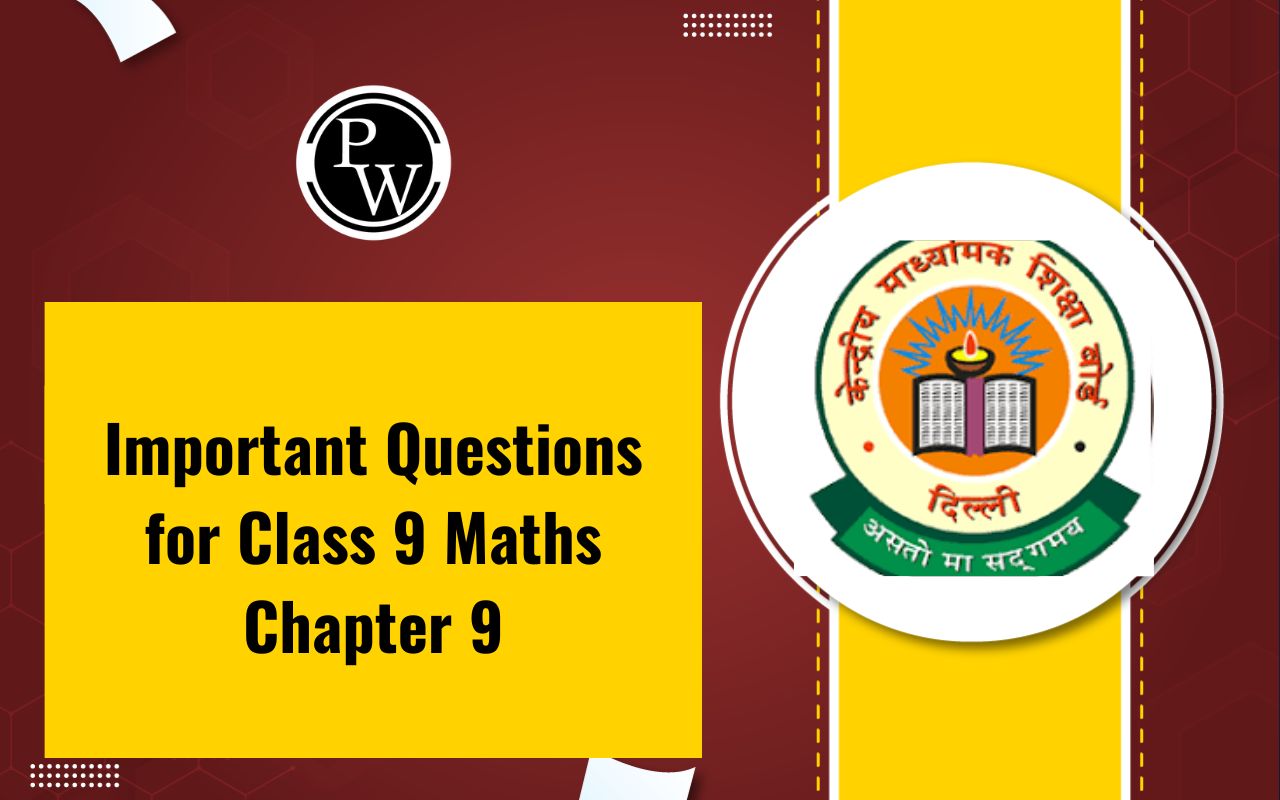

Important Questions for Class 9 Maths Chapter 9: Here are the important questions for Class 9 Maths Chapter 9 Areas of Parallelograms & Triangles are prepared by subject experts. These questions are created to help students understand key concepts and improve their problem-solving skills.
Practicing these questions will help students gain a deeper understanding of the chapter and perform better in exams. By solving these important questions students can focus on the topics that are most likely to appear in the exam and improve their confidence in handling different types of problems. The PDF link for these important questions is available below for easy access and reference.Important Questions for Class 9 Maths Chapter 9 Overview
These important questions for Class 9 Maths Chapter 9 Areas of Parallelograms and Triangles has been prepared by subject experts of Physics Wallah. They are created to help students thoroughly understand the concepts of areas and apply them to solve problems efficiently. By practicing these questions students can reinforce their understanding of the relationships between parallelograms and triangles as well as improve their problem-solving techniques. These expert-created questions will guide students in focusing on important topics boosting their confidence for the exams.Important Questions for Class 9 Maths Chapter 9 PDF
The important questions for Class 9 Maths Chapter 9 Areas of Parallelograms and Triangles are available in the PDF link provided below. By practicing these questions students can enhance their understanding of the chapter and prepare effectively for their exams. Download the PDF to access these valuable resources and start your preparation now.Important Questions for Class 9 Maths Chapter 9 PDF
Important Questions CBSE Class 9 Maths Chapter 9 Areas of Parallelograms & Triangles
Here we have provided Important Questions CBSE Class 9 Maths Chapter 9 Areas of Parallelograms & Triangles-Question 1: In ABCD is a parallelogram, AE ⊥ DC and CF ⊥ AD. If AB = 16 cm, AE = 8 cm and CF = 10 cm, find AD.
Solution:
Given, AB = CD = 16 cm (Opposite sides of a ||gm are equal) CF = 10 cm and AE = 8 cm Now, Area of parallelogram = Base × Altitude = CD × AE = AD × CF ⇒ 16 × 8 = AD × 10 ⇒ AD = 128/10 ⇒ AD = 12.8 cmQuestion 2: If E, F, G and H are respectively the mid-points of the sides of a parallelogram ABCD, show that ar (EFGH) = 1/2 ar(ABCD).
Solution:
Given, E, F, G and H are the mid-points of the sides of a parallelogram ABCD, respectively. To Prove: ar (EFGH) = ½ ar(ABCD) Construction: H and F are joined. Proof: AD || BC and AD = BC (Opposite sides of a ||gm) ⇒ ½ AD = ½ BC Also, AH || BF and and DH || CF ⇒ AH = BF and DH = CF (H and F are midpoints) Therefore, ABFH and HFCD are parallelograms. Now, As we know, ΔEFH and ||gm ABFH, both lie on the same FH the common base and in-between the same parallel lines AB and HF. ∴ area of EFH = ½ area of ABFH — (i) And, area of GHF = ½ area of HFCD — (ii) Adding (i) and (ii), area of ΔEFH + area of ΔGHF = ½ area of ABFH + ½ area of HFCD ⇒ ar (EFGH) = ½ ar(ABCD)Question 3: P is a point in the interior of a parallelogram ABCD. Show that
(i) ar(APB) + ar(PCD) = ½ ar(ABCD) (ii) ar(APD) + ar(PBC) = ar(APB) + ar(PCD) [Hint : Through P, draw a line parallel to AB.]Solution:
(i) A line GH is drawn parallel to AB passing through P. In a parallelogram, AB || GH (by construction) — (i) ∴, AD || BC ⇒ AG || BH — (ii) From equations (i) and (ii), ABHG is a parallelogram. Now, ΔAPB and ||gm ABHG are lying on the same base AB and in-between the same parallel lines AB and GH. ∴ ar(ΔAPB) = ½ ar(ABHG) — (iii) also, ΔPCD and ||gm CDGH are lying on the same base CD and in-between the same parallel lines CD and GH. ∴ ar(ΔPCD) = ½ ar(CDGH) — (iv) Adding equations (iii) and (iv), ar(ΔAPB) + ar(ΔPCD) = ½ {ar(ABHG) + ar(CDGH)} ⇒ ar(APB) + ar(PCD) = ½ ar(ABCD) (ii) A line EF is drawn parallel to AD passing through P. In the parallelogram, AD || EF (by construction) — (i) AB || CD ⇒ AE || DF — (ii) From equations (i) and (ii), AEDF is a parallelogram. Now, ΔAPD and ||gm AEFD are lying on the same base AD and in-between the same parallel lines AD and EF. ∴ ar(ΔAPD) = ½ ar(AEFD) — (iii) also, ΔPBC and ||gm BCFE is lying on the same base BC and in-between the same parallel lines BC and EF. ∴ ar(ΔPBC) = ½ ar(BCFE) — (iv) Adding equations (iii) and (iv), ar(ΔAPD) + ar(ΔPBC) = ½ {ar(AEFD) + ar(BCFE)} ⇒ ar(APD) + ar(PBC) = ar(APB) + ar(PCD)Question 4: In a triangle ABC, E is the mid-point of median AD. Show that ar(BED) = 1/4 ar(ABC).
Solution:
ar(BED) = ½ × BD × DE Since, E is the mid-point of AD, AE = DE Since, AD is the median on side BC of triangle ABC, BD = DC DE = ½ AD — (i) BD = ½ BC — (ii) From (i) and (ii), we get, ar(BED) = (1/2) × (½) BC × (1/2)AD ⇒ ar(BED) = (½) × (½) ar(ABC) ⇒ ar(BED) = ¼ ar(ABC)Question 5: ABC and ABD are two triangles on the same base AB. If line- segment CD is bisected by AB at O, show that: ar(ABC) = ar(ABD).
Solution:
In ΔABC, AO is the median. (CD is bisected by AB at O) ∴ ar(AOC) = ar(AOD) — (i) also, ΔBCD, BO is the median. (CD is bisected by AB at O) ∴ ar(BOC) = ar(BOD) — (ii) Adding (i) and (ii), ar(AOC) + ar(BOC) = ar(AOD) + ar(BOD) ⇒ ar(ABC) = ar(ABD)Question 6: D, E and F are respectively the mid-points of the sides BC, CA and AB of a ΔABC.
Show that (i) BDEF is a parallelogram. (ii) ar(DEF) = ¼ ar(ABC) (iii) ar (BDEF) = ½ ar(ABC)Solution:
(i)In ΔABC, EF || BC and EF = ½ BC (by midpoint theorem) also, BD = ½ BC (D is the midpoint) So, BD = EF also, BF and DE are parallel and equal to each other. Therefore, the pair opposite sides are equal in length and parallel to each other. ∴ BDEF is a parallelogram. (ii) Proceeding from the result of (i), BDEF, DCEF, AFDE are parallelograms. Diagonal of a parallelogram divides it into two triangles of equal area. ∴ ar(ΔBFD) = ar(ΔDEF) (For ||gm BDEF) — (i) also, ar(ΔAFE) = ar(ΔDEF) (For ||gm DCEF) — (ii) ar(ΔCDE) = ar(ΔDEF) (For ||gm AFDE) — (iii) From (i), (ii) and (iii) ar(ΔBFD) = ar(ΔAFE) = ar(ΔCDE) = ar(ΔDEF) ⇒ ar(ΔBFD) + ar(ΔAFE) + ar(ΔCDE) + ar(ΔDEF) = ar(ΔABC) ⇒ 4 ar(ΔDEF) = ar(ΔABC) ⇒ ar(DEF) = ¼ ar(ABC) (iii)Area (||gm BDEF) = ar(ΔDEF) + ar(ΔBDE) ⇒ ar(BDEF) = ar(ΔDEF) + ar(ΔDEF) ⇒ ar(BDEF) = 2× ar(ΔDEF) ⇒ ar(BDEF) = 2× ¼ ar(ΔABC) ⇒ ar(BDEF) = (1/2)ar(ΔABC)Question 7: Diagonals AC and BD of quadrilateral ABCD intersect at O such that OB = OD.
If AB = CD, then show that: ar (DOC) = ar (AOB) ar (DCB) = ar (ACB) DA || CB or ABCD is a parallelogram. [Hint: From D and B, draw perpendiculars to AC.]Solution:
Given: OB = OD and AB = CD Construction: DE ⊥ AC and BF ⊥ AC are drawn. Proof: (i) In ΔDOE and ΔBOF, ∠DEO = ∠BFO (Perpendiculars) ∠DOE = ∠BOF (Vertically opposite angles) OD = OB (Given) ∴, ΔDOE ≅ ΔBOF (by AAS congruence criterion) ∴, DE = BF (By CPCT) — (1) also, ar(ΔDOE) = ar(ΔBOF) (Congruent triangles) — (2) Now, In ΔDEC and ΔBFA, ∠DEC = ∠BFA (Perpendiculars) CD = AB (Given) DE = BF (From eq.1) ∴, ΔDEC ≅ ΔBFA (by RHS congruence criterion) ∴, ar(ΔDEC) = ar(ΔBFA) (Congruent triangles) — (3) Adding (2) and (3), ar(ΔDOE) + ar(ΔDEC) = ar(ΔBOF) + ar(ΔBFA) ⇒ ar (DOC) = ar (AOB) (ii) ar(ΔDOC) = ar(ΔAOB) Adding ar(ΔOCB) in LHS and RHS, we get, ⇒ ar(ΔDOC)+ar(ΔOCB)=ar(ΔAOB)+ar(ΔOCB) ⇒ ar(ΔDCB) = ar(ΔACB) (iii) When two triangles have the same base and equal areas, the triangles will be in between the same parallel lines ar(ΔDCB) = ar(ΔACB) DA || BC — (4) For quadrilateral ABCD, one pair of opposite sides are equal (AB = CD) and other pair of opposite sides are parallel. ∴, ABCD is a parallelogram.Question 8: XY is a line parallel to side BC of a triangle ABC. If BE || AC and CF || AB meet XY at E and F respectively, show that
ar(ΔABE) = ar(ΔACF)Solution:
Given: XY || BC, BE || AC and CF || AB To show: ar(ΔABE) = ar(ΔACF) Proof: BCYE is a ||gm as ΔABE and ||gm BCYE are on the same base BE and between the same parallel lines BE and AC. ∴, ar(ABE) = ½ ar(BCYE) … (1) Now, CF || AB and XY || BC ⇒ CF || AB and XF || BC ⇒ BCFX is a parallelogram As ΔACF and ||gm BCFX are on the same base CF and in-between the same parallel AB and FC. ∴, ar (ΔACF)= ½ ar (BCFX) … (2) But, ||gm BCFX and ||gm BCYE are on the same base BC and between the same parallels BC and EF. ∴, ar (BCFX) = ar(BCYE) … (3) From (1) , (2) and (3) , we get ar (ΔABE) = ar(ΔACF) ⇒ ar(BEYC) = ar(BXFC) As the parallelograms are on the same base BC and in-between the same parallels EF and BC…..(4) Also, △AEB and ||gm BEYC is on the same base BE and in-between the same parallels BE and AC. ⇒ ar(△AEB) = ½ ar(BEYC) ……(5) Similarly, △ACF and ||gm BXFC on the same base CF and between the same parallels CF and AB. ⇒ ar(△ ACF) = ½ ar(BXFC) ……..(6) From (4), (5) and (6), ar(△AEB) = ar(△ACF)Question 9: Parallelogram ABCD and rectangle ABEF are on the same base AB and have equal areas. Show that the perimeter of the parallelogram is greater than that of the rectangle.
Solution:
Given, ||gm ABCD and a rectangle ABEF have the same base AB and equal areas. To prove, The perimeter of ||gm ABCD is greater than the perimeter of rectangle ABEF. Proof, As we know, the opposite sides of a||gm and rectangle are equal. AB = DC [As ABCD is a ||gm] and, AB = EF [As ABEF is a rectangle] DC = EF … (i) Adding AB on both sides, we get, ⇒ AB + DC = AB + EF … (ii) As we know, the perpendicular segment is the shortest of all the segments that can be drawn to a given line from a point not lying on it. BE < BC and AF < AD ⇒ BC > BE and AD > AF ⇒ BC + AD > BE + AF … (iii) Adding (ii) and (iii), we get AB + DC + BC + AD > AB + EF + BE + AF ⇒ AB + BC + CD + DA > AB + BE + EF + FA ⇒ perimeter of ||gm ABCD > perimeter of rectangle ABEF. The perimeter of the parallelogram is greater than that of the rectangle.Question 10: Diagonals AC and BD of a quadrilateral ABCD intersect each other at E. Show that
ar(ΔAED) × ar(ΔBEC) = ar (ΔABE) × ar (ΔCDE). [Hint: From A and C, draw perpendiculars to BD.]Solution:
Given: The diagonal AC and BD of the quadrilateral ABCD, intersect each other at point E. Construction: From A, draw AM perpendicular to BD From C, draw CN perpendicular to BD To Prove: ar(ΔAED) ar(ΔBEC) = ar (ΔABE) ar (ΔCDE) Proof: ar(ΔABE) = ½ ×BE×AM………….. (i) ar(ΔAED) = ½ ×DE×AM………….. (ii) Dividing eq. (ii) by (i) , we get, ar(ΔAED)/ar(ΔABE) = [1/2×DE×AM]/ [1/2×BE×AM] = DE/BE ………..(iii) Similarly, ar(ΔCDE)/ar(ΔBEC) = DE/BE …….(iv) From eq. (iii) and (iv), we get; ar(ΔAED)/ar(ΔABE) = ar(ΔCDE)/ar(ΔBEC) Therefore, ar(ΔAED) × ar(ΔBEC) = ar (ΔABE) × ar (ΔCDE)Benefits of Practicicng Important Questions for Class 9 Maths Chapter 9
Practicing the important questions for Class 9 Maths Chapter 9 Areas of Parallelograms and Triangles provide several benefits:Strengthens Conceptual Understanding : These questions are created to reinforce key concepts, helping students grasp the fundamentals of areas of parallelograms and triangles.
Boosts Problem-Solving Skills : Regular practice improves analytical and problem-solving abilities, enabling students to tackle various types of questions with confidence.
Prepares for Exams : Practicing these questions helps students familiarize themselves with the exam format and frequently asked topics enhancing exam readiness.
Improves Time Management : By solving these questions students learn to manage their time effectively, ensuring they can complete their exam papers on time.
Builds Confidence : Regular practice of important questions helps students feel more confident about their knowledge reducing exam anxiety.
Important Questions for Class 9 Maths Chapter 9 FAQs
What is a parallelogram?
What is a triangle?
How do you find the area of a parallelogram on the same base and between the same parallels?
Can two triangles have the same area?












